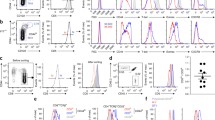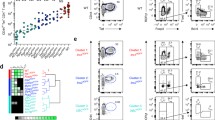Abstract
We previously showed that the cell surface-expressed M r 70,000 heat shock cognate (hsc70, a constitutively expressed member of the hsp70 family) protein-like molecule (#067 molecule) interacts with rat CD3+, CD4–, CD8–, T-cell receptor (TCR)αβ–, natural killer recetor-P1– T cells. This 70hsc-like molecule was also suggested to present cellular peptide antigens to these T cells. In the present study, we identified the genetic structure of the TCR by establishing T-cell hybridomas between these T cells and mouse BW5147 cells. Our data indicated that these T cells preferentially used TCRs with the Vδ6 family. Analysis of the nucleotide sequence of the CDR3 junctional portion showed that there are substantial diversities, with insertion of seven to nine amino acid residues. These data provide indirect evidences for our hypothesis that an hsc70-like molecule could be presented together with cellular peptide antigens to particular T cells with TCR γδ chains. Since the expression of this hsc70-like #067 antigen on the cell surface is usually induced along with cell transformation by activated oncogenes, T cells with the TCR Vδ6 family are likely to contribute to host resistance to tumor cells.
Similar content being viewed by others
Author information
Authors and Affiliations
Additional information
Electronic Publication
Rights and permissions
About this article
Cite this article
Kishi, A., Ichinohe, T., Hirai, I. et al. The cell surface-expressed HSC70-like molecule preferentially reacts with the rat T-cell receptor Vδ6 family. Immunogenetics 53, 401–409 (2001). https://doi.org/10.1007/s002510100335
Received:
Accepted:
Published:
Issue Date:
DOI: https://doi.org/10.1007/s002510100335




